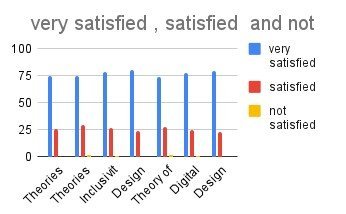
1. Overall, how satisfied were you with the symposium?
From the above shown graph 74.5% participants were very satisfied with the symposium and only 26.2% contended that it could make their practice better. Further we can also observe 74.8% attended felt theories of metacognition was very educational and were very well satisfied and 29.1% felt contended only 1.9% was disappointed with it. 78.2% participates stated that the session on inclusivity in education was beneficial to them and was very satisfied, about 26.6% partakers were gratified and only 0.8% attendees showed dissatisfaction. 80.2% participates was very satisfied with the design thinking session and only 24.1% showed unhappiness. Further 73.8% attended were very satisfied and 28.1% felt that it could make their learning visible and lastly 1.8% showed their dissatisfaction. Lastly 77.2% participants perceived that digital transformation in education was very satisfying. 24.6 % felt contended and only a small group of people 0.7% felt disappointment.
Summary: – After overviewing the graph we can elaborate that the overall symposium was highly appreciated and liked specially sessions on design thinking and inclusivity in education. As we can clearly see very few participates did not feel contended with theories on metacognition and inclusivity some of the reasons behind it can be limited timing for both the theories.
Corrective measure: – We can come up with the measures that can help the participants to connect with the topics and the examples given during the symposium. Further we can also plan activities where they can actively participate this will make the whole session engaging.
Total No. of registration:-1049
Total No. of attendees:-769
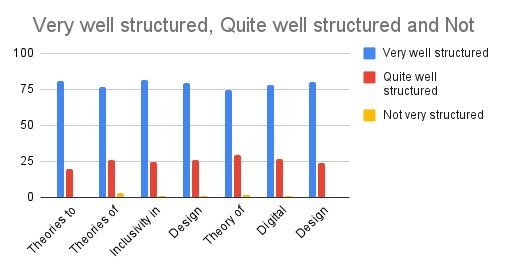
2. Was the symposium structured for allowing you to attend more than one breakout session?
As we can clearly observe as shown in the data 80.9% participates felt that the symposium was very well structured that allowed them to attend more than one breakout session and 19.9% felt it was flawless and which could make their practice better. From the graph it is clear that 76.7 % attended felt theories of metacognition required to be structured and some participants did experience it to be well structured with a few participates about 2.9% observed it to be unstructured. 81.5 % stated that the symposium was inclusive and very well structured and 24.2% commented that it was quite well organized were as 0.8% perceived it was disorderly 79.3% experienced that the problem solving session was extremely well organized and 25.9% observed it was quite perceived well were as 0.9% felt it was unstructured. 74.8% felt the session on visible learning was well structured, 29.1 % showed some discern and 1.9% felt it was not at all structured. Lastly 78.2% participants felt digital transformation was very well structured were as 26.6% showed some discern and only 0.8% is was not at all structured.
Summary :- An overview just shows a positive trend on inclusivity and very few participants felt that theories of metacognition was not very well structured. Though few attendees may not be aware of the theory. They might have experienced the idea/examples used by the host or the session was very abstract. The other reasons behind it can be that topic itself was were conceptual and required in-depth idea about the concept.
Corrective measures :- The symposium structure ismeant togive new insights and abilities. Its main purpose is to inform about a process or plan to either fix a problem or learn something new. The presenter’session might have been like a climb uphill that takes you over a hurdle and on to a positive resolution.
Total No. of registration:-1049
Total No. of attendees:-769
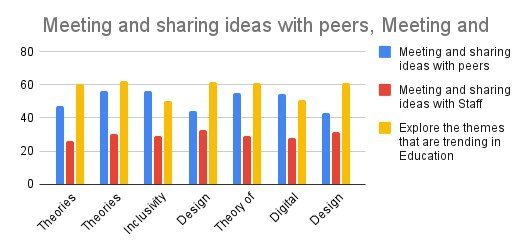
3. What were your reasons for attending the symposium?
From above shown statistics we can generalized 47.5% participants attended the symposium for meeting and sharing the ideas with peers and 26.2% for sharing ideas with staff and 60.3% only attended to explore the themes that are trending in education related to theories that they can practice. 56.3% attendee’s participated only to meet and share ideas with their peers where as 30.1% attendees took part for sharing ideas with staff whereas remaining 62.1% came to explore the themes that are trending in metacognition. For Inclusivity in education part 56.5% and 29% participants attended to share the ideas with peers and staff and the remaining 50% is for to investigate the themes trending in education. In the design thinking scenario 44% and 32.8% attendees participated for sharing the ideas with peers and staff respectively while 62% attended to dig into new trends in education. Further 55.3% & 29.1% took part in order to share ideas with their peer and staffs and almost 61.1% attended in order to explore new ideas. 54.5% and 28% attended with the idea of sharing it with their peers and staffs and 51% participant actually attended to explore the ideas related to digital transformations in education.
Summary :- An overview shows that most of the participants who attended the symposium wanted to explore the new trends and themes in education in relation with all the theories. It can also be observed participants cherished the idea of discussion among staff and peers as they may believe that it can give them better exposure and understanding.
Total No. of registration :-1049
Total No. of attendees :-769
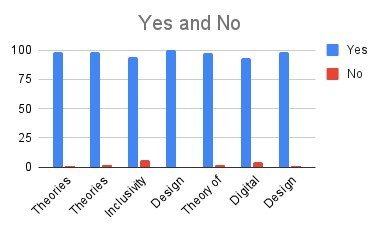
4. Did the symposium meet your expectations of the above?
As we can clearly generalize from above shown graphs 98.6% attendees stated theories to practiced met their expectation and only 1.4% felt little disappointment 98.1% participates showed that theories on metacognition was highly appreciated and 1.9% found it abstract 94.2% attendee’s showed fondness for inclusivity where as 5.8% participates felt disappointment. Session on design thinking showed 100% result it means all the participants was highly satisfied. 97.1% participants highly appreciated the session on visible learning and 1.8% showed little disdain. Lastly 93.2% participant showed acknowledgment towards session on digital transformation and 4.8% felt it does not meet with expectation.
Summary :- As we can clearly see session on design thinking were highly appreciated and liked by all the participantsfollowed by discussion on theories to practice and metacognition. There are very few participants who showed some dissatisfaction which may due to exaggerated topics or due to lack of interconnection between the sessions. Participants might have felt lethargic due to post lunch etc. Here we can state that the symposium at least meet some criteria of the participants.
Corrective measures :- In order to meet up to the expectation of the participants we first need to check their understanding of the topics that are to be discussed in the symposium. This isn’t about micromanaging someone, but it is about being aware, offering support, and expressing encouragement when people are struggling. You might even identify with the individual how often they would like you to check in with them at the beginning of a session and throughout the process.
Total No. of registration:-1049
Total No. of attendees:-769
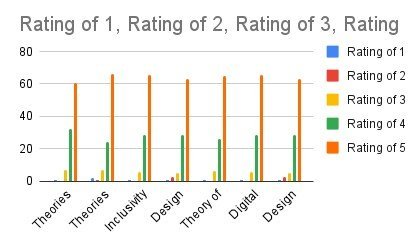
5. Please rate the breakout session you attended (5-highest rated through to 1 - lowest rated)
From the above shown graphs we can interpreted that breakout session attended by the participants has the highest rating of 60.3% and lowest rating of 0.7% in theories related to practiced. 66% was the extreme rating given by the attendees in the context of metacognition and the lowest was 1.9%. In the respect to inclusivity and design thinking the highest ratings was 65.3% and 62.9% respectively and the lowest was 0.8% and 0.9% respectively. Lastly for session on visible learning and digital transformation the highest rating was 65% and 65.3% and the lowest was 0.7% and 0.8% respectively.
Summary :- From the overview we can clearly see that all the theories mostly received the highratings it indicates that breakout session where able to involve maximum participates. We can also states that only few participants showed some dissatisfaction that may be due to some huddles or errors during the sessions.
Corrective measures :- In order to improve the gaps between the ratings first we have find whether everything goes according to plan by including the Plan-Do-Check –Act cycle in implemented. This can help launching a successful corrective action system well within reach. The corrective actions are taken to fine-tune the system to the point that nonconformance’s are reliably detected, evaluated, and resolved.
Total No. of registration :-1049
Total No. of attendees :-769
Reflections from the Convener : Ms. Dhanisha Benoy
The experience of conducting an event can be very much overwhelming looking at the scale and magnitude of expectations with oneself Vs the outcome of the event. My favorite part of the events would be the skills I personally polished as a professional to adapt to different styles of work depending on the individual, one had to partner and the efficacy I developed in communicating with varied stakeholders involved in the event. If I had to talk about the professional achievements there are many to quote. It wouldn’t be fair to not express the insight I have managed to achieve about the varied themes discussed during the Symposium. We were able to meet most of our goals like connecting with other educators all across the globe, sharing insights and communicating best practices, understanding the importance of access to a space to discuss trends and focus areas in the field of education. No work is ever perfect therefore we too have areas to improve on and the list is definitely long this includes managing time and focus on deadlines in line with SOW (Statement of work). Start risk assessment at a very early stage to avoid pitfalls.
The aim of using resources has to be maximized to avoid wastefulness of resources.
This brings back the focus on human resource and financial resource. As a reflection to what was done while working on the project human resource and financial resources had to be chalked out at a very early stage of project initiation as this could have allowed more efficient use of resources. The area of improvement would be work on team building to be able to focus on achieving a shared goal will be something we need to ponder on.
There is no better learning than learning by doing I personally got to learn personally and professionally. We will have to work on effectively following the five steps involved in creating a communication and promotion plan are: (1) establishing goals; (2) defining key audiences; (3) identifying key messages; (4) creating a tactical outreach plan; and (5) specifying a timeline for moving forward. It is very important to keep these factors in mind and revisit them periodically as a team till the event is executed.
Conclusion : As a teacher education Institute Rahul College of education is involving itself as an organization keen in evolving and understanding of how best to teach in 21st Century, including the NEP 2020, represents a significant transition in the way education is currently taught in most classrooms and will require most teachers to alter the way they teach. The available evidence suggests that many teachers have not had sufficiently rich experiences with the content relevant to the courses they currently teach, let alone a substantially redesigned curriculum. Very few teachers have experience with the practices described in the NEP 2020.
Typically, the selection of and participation in professional learning opportunities is up to individual teachers. There is often little attention to developing collective capacity for teaching at the building and district levels or to offering teachers learning opportunities tailored to their specific needs and offered in ways that support cumulative learning over time.
Teachers’ learning needs are shaped by their preparation, the grades and content areas they teach, and the contexts in which they work. Three important areas in which teachers need to develop expertise is the knowledge, capacity, and skill required to support a diverse range of students; content knowledge, including understanding of disciplinary core ideas, crosscutting concepts, and scientific practices; and pedagogical content knowledge for teaching, including a repertoire of teaching practices that support students in rigorous and consequential learning. Konnekt 2k22 was an effort in this direction of understanding the importance of significant transition in education.
Get in Touch
1800 210 1002

